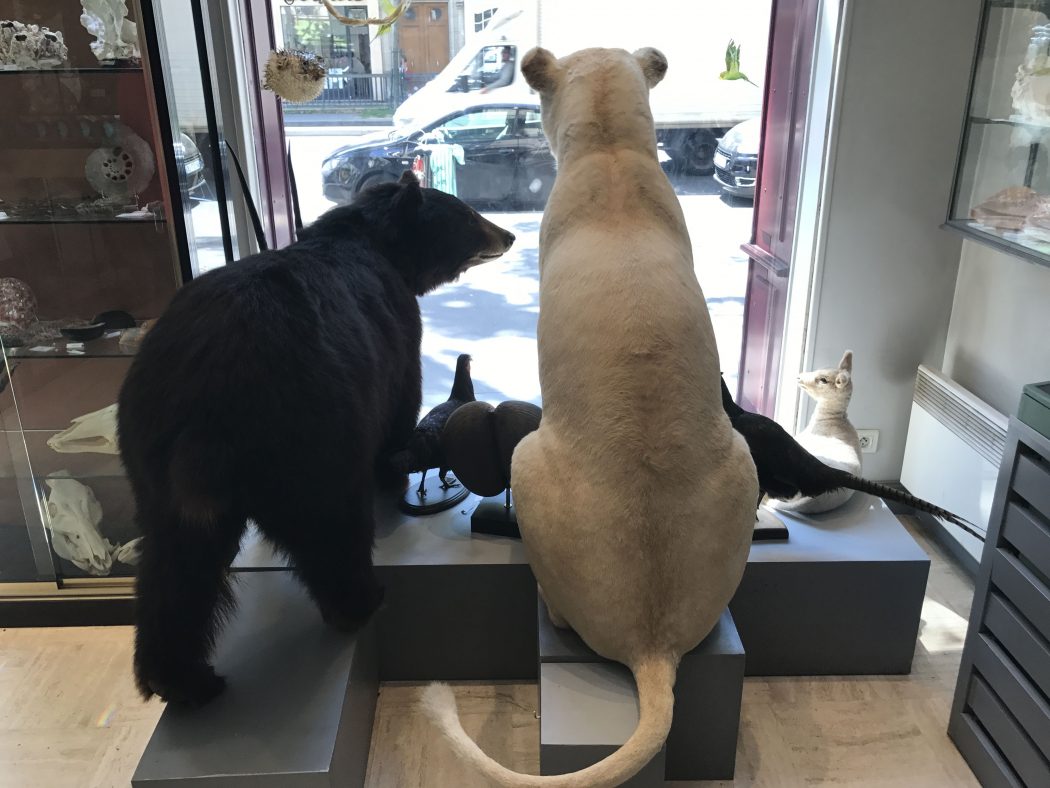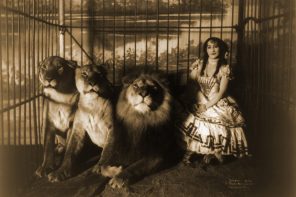If the citizens of Narnia ever held a parliament, it would look like the showroom at Design et Nature in Paris, where tigers, polar bears and swans gather peacefully together.
Except the animals aren’t talking, or even moving.
They’re stuffed.
The rhinoceros whose head hangs on the wall is stuffed, and so is the giraffe, which still has its head, but not its body (what happened to it?). Dead butterflies burst artfully upwards, a swan glides to nowhere and a white rabbit checks its watch. Owner Anna Orlowska is famous for these life-like specimens, often borrowed for fashion spreads.
There were once stores like this all over the world, but a combination of changing tastes and the Washington Convention – an international treaty that restricts the trade of animals – has led to a decline in exotic animal taxidermy. Paris, where raising the dead remains a high art, is the last holdout. Yet if you fancy lining your walls with animals that have been reincarnated legally, you’d better visit sooner rather than later.
French taxidermists work within the law, according to Orlowska’s son Timothé Mingasson. “We have papers for every animal,” he says, adding that the most sought-after animal is the peacock. “We’d sell one every day if we could get our hands on enough.”
That’s a good thing for the trade, because peacocks will shortly be one of the few animals that can be sold legally. At the moment, taxidermists are supplied with wild animals from circuses and zoos, explains Timothé. As soon as one of the major attractions dies, circus owners ring the taxidermists, because they don’t have refrigeration and need to dispose of the animal as fast as possible. Zoos are better equipped, so they have time to consider what to do with the animals. Their options include donating the animal to natural history museums or scientific research, to simply incinerating the bodies.
This means a crisis is bearing down on taxidermy: One by one, European countries are banning the use of wild animals in circuses, so the pool of future specimens is drying up.
The white lioness in the window at Claude Nature, for example, may be the last the shop ever has. Born and raised in captivity, she now spends her afterlife glassily staring at Boulevard St Germain.
Hervé, who minds the store but won’t give his last name, says efforts to ban wild animals in circuses have picked up pace. This year, Latvia and Romania joined the 19 other European countries that ban or restrict wild animal acts.
Fortunately for Hervé’s job, the majority of what’s sold at Claude Nature are farmed beetles and butterflies. The walls positively glitter with golden jewel scarabs and iridescent Blue Morpho butterflies from South America. “And here are gifts for mother-in-laws,” says Hervé, opening a drawer. Spiders of all shapes and sizes come into view. In their centre, a hairy tarantula.
The store’s most popular animals are the crows and European jays. The least popular? Hervé points to the young camel. “Nobody wants a dromedary,” he says sadly.
Deyrolle is in less danger of running out of specimens than of space in which to house them. Spread over two levels, it’s got lions, tigers, a zebra, a giraffe, skeletons, exotic birds galore and dead mice popping in and out of drawers, plus scientific and mineral specimens, books and posters. In business since 1831, it suffered a disaster in 2008 when the insect cabinet caught fire. So valued is the shop, that a group of artists raised enough money to reconstruct the collection. Unfortunately, taking photographs is not allowed.
At least it’s possible to take a good look around, which generally can’t be done elsewhere. London’s taxidermy stores, for example, are only open by appointment and mostly sell or rent specimens, many from taxidermy’s heyday in the 19th century. Alexis Turner, owner of London Taxidermy and author of Taxidermy, says it was the development of arsenic paste that kicked off taxidermy mania. “The stuff that’s kind of lasted mostly dates from after 1850,” he says, adding that taxidermist Rowland Ward perfected the paste.
Today, Ward’s name is so renowned that finding one of his pieces is a lot like finding a Fabergé egg in the attic – a cause for celebration. You need to know what you’re doing, however, because many old pieces are in poor condition and not worth anything. If you want something, you’re better off buying it from Turner, who also rents out his collection for photo shoots. “I only buy pieces from animals that have died naturally or accidentally or are on the secondary market, so I might buy a giraffe’s head from the collection of a big game hunter.” He says he doesn’t know what happens to the rest of the giraffe, but adds that he does have a complete one. His most sought after animal, he says, is the crow. “You can use them for all sorts of sinister things, like horror movies.” Most unpopular? “The chipmunk.”
If you’re just looking for holiday taxidermy fun, there is always the hands-on option.
Taxidermy courses have been proliferating since Alexander McQueen used stuffed wild animals in a 2009 fashion show. Rosemary Hamilton, who runs classes at the London Taxidermy Academy, says while short courses in stuffing mice used to be popular – “they are good as a test workshop if you are unsure what to expect” – people have moved on to more complicated animals, “such as mounting large birds or the preservation of tiny butterflies and beetles”. An afternoon spent learning to stuff a guinea pig will set you back £44.00, while the rat course is a steal at just £34.00. Unfortunately, the mole class is sold out at the time of writing, as is the two-day peacock course (£349.00).
There are no exotic animals involved. Rosemary says that laws in the UK are so strict, that taxidermists can only mount a maximum of 15 birds a year. Even if British zoos were open to supplying specimens, she thinks, the paperwork would be too onerous. “Most professional taxidermists make sales through commissions and not from creating taxidermy.”
Rosemary adds that 50% of her students are vegan or vegetarian, 90% of them are female, and many of them are returning customers. It’s nice to see people creating their own pieces, she says. Maybe there ought to be an annual event where amateurs can introduce their animals to each other. A Narnian funeral convention, perhaps.
This piece first appeared at Columbia Travel Media, August 2017.




